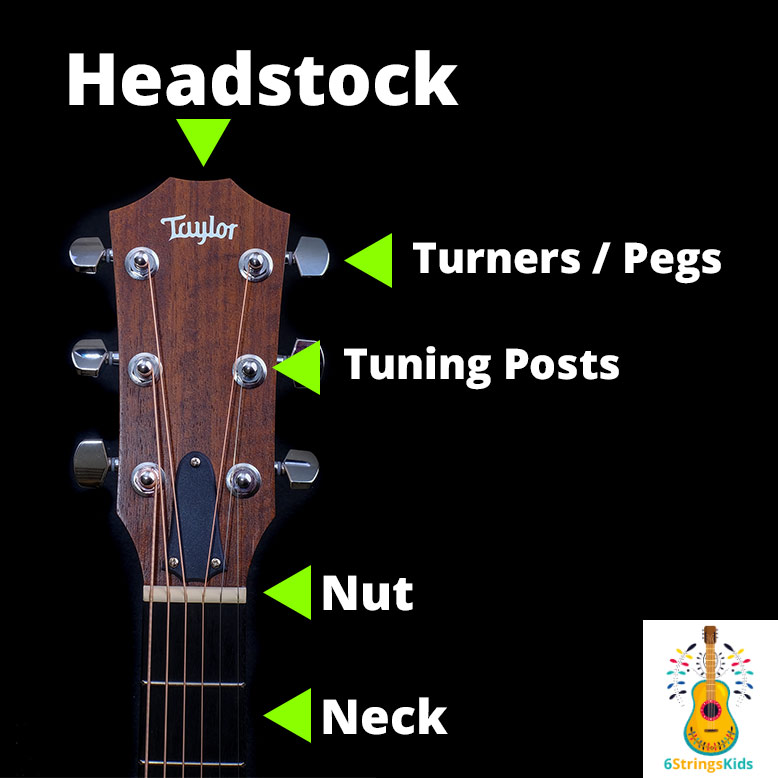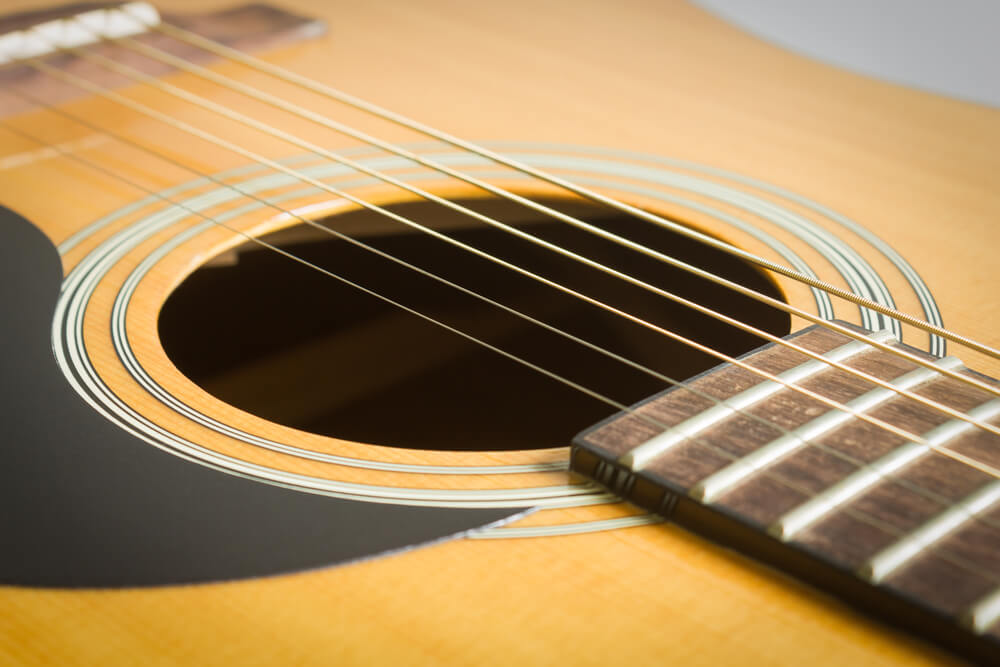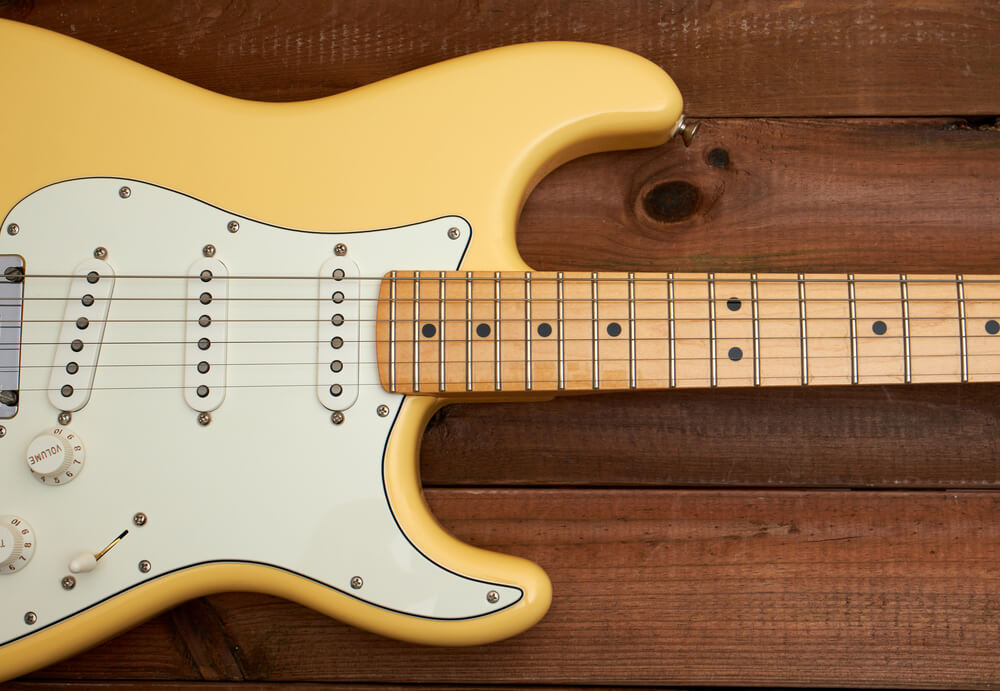Diving into the world of guitars can be an exciting adventure, but understanding the various guitar parts names and their functions is crucial for mastering your instrument. Whether you’re a beginner or a seasoned player, the anatomy of a guitar plays a vital role in shaping your sound and technique. In this comprehensive guide, we’ll explore the essential components of electric and acoustic guitars, delving into the nuances of neck shapes, body styles, and materials, so you can confidently unleash your musical potential.
Short Summary
- Guitar parts names are essential for mastering the instrument. From headstocks and nuts to sound holes, pickups, bridge pins and more.
- Electric guitars possess specialized components such as pickups, electronics & tremolo arms for creating unique sounds.
- Different guitar body styles & neck shapes provide distinct tonal qualities & playability characteristics.
The Essentials of Guitar Parts Names

Every guitar, whether acoustic or electric, has three primary components: the headstock, neck, and body. These parts work in harmony to create the beautiful sounds we’ve come to associate with the instrument. The headstock houses the tuning pegs, while the nut marks the vibrating length of the strings. The body of the guitar plays a crucial role in producing the instrument’s unique sound.
The neck supports the fretboard, which is where the magic of guitar playing truly happens. As we dive deeper into the world of guitars, keep in mind that understanding these essential parts will lay the foundation for your guitar journey, ultimately enhancing your playing abilities.
Headstock
The headstock is the part of the guitar where the strings are attached, whether you’re playing an electric or acoustic guitar. It serves as the anchor point for the tuning pegs, which are used to adjust the tension and pitch of the strings. The three primary headstock configurations are 3 tuners per side, in-line tuners, and classical tuners. The in-line tuner configuration, popularized by Fender guitars, is commonly found on electric guitars.
The headstock also houses the truss rod, a metal bar installed along the length of the neck that provides increased rigidity and allows for bending and straightening. This essential component plays a crucial role in maintaining the stability and alignment of the neck, ensuring optimal playability and sound quality.
Headless guitars, which lack tuning pegs, have gained popularity for their lighter weight and increased comfort while playing, although tuning may be more challenging in this design.
Nut
The nut is a small piece of material, typically made from plastic, bone, ivory, or other materials, that sits at the junction of the neck and headstock. It determines the top end of the playable portion of the strings, as well as defines the spacing and height of the action between the strings and the frets. The nut plays a critical role in the guitar’s intonation, as it sets the length at which the strings vibrate, ensuring the correct pitch for each note.
Different types of nuts exist, including locking nuts, rolling nuts, and compensated nuts. Locking nuts, which have become increasingly popular with the rise of tremolo bars, help keep the strings in tune after tuning by securing them in place. This prevents them from slipping, which can result in fret buzz and other undesirable sounds.
Neck
The neck of a guitar is typically constructed from wood, with maple and mahogany being the most commonly used materials. The neck provides length to the strings, bears the tension of the strings, and supports the fretboard, which is a thin, long strip of material, usually, wood, affixed to the neck. The fretboard is where you press the strings to create notes and chords, and its design can significantly impact the playability and tone of the guitar.
Embedded along the neck are metal strips called frets, which shorten the string and raise the pitch of the note by a half-step or semitone when pressed. This allows for precise note selection, and if a fret is incorrectly installed, it can cause the intonation to be off and the notes to be incorrect. To maintain the stability of the neck, a truss rod is installed along its length. This metal bar can be adjusted to straighten or bend the neck, ensuring optimal playability and sound quality.
The neck joint, the point of connection between the neck and the body, can either be a bolt-on neck or a set-in neck. Bolt-on necks attach using four screws, while set-in necks are secured with glue. The type of neck joint used can affect the guitar’s resonance, sustain, and overall tonal qualities.
Fretboard/Fingerboard
The fretboard, also known as the fingerboard, is where the true magic of guitar playing happens. It’s a wooden surface, typically made of rosewood or maple, featuring inlay markers that help guide your fingers to the correct fret positions. When you press the strings against the fretboard, you create different notes and chords, shaping the melodies and harmonies that make up your unique sound.
The materials used for the fretboard can greatly impact the tone and playability of the guitar. Hardwoods like ebony and rosewood are often used for their durability and tonal qualities, but other materials such as synthetic composites and even metals can be found in some guitars. The inlays on the fretboard, often made of materials like mother-of-pearl or albalone, serve both an aesthetic purpose and a practical one, helping you navigate the frets as you play.
Acoustic Guitar-Specific Parts

While electric and acoustic guitars share many similarities, acoustic guitars possess specific components that set them apart. These parts, such as the sound hole, bridge pins, and rosette, play a crucial role in sound production and playability, creating the rich, warm tones that acoustic guitars are known for. One such component is the acoustic guitar bridge, which helps anchor the strings and transfer their vibrations to the guitar’s body. In contrast, the electric guitar bridge serves a similar purpose but is designed for use on electric guitars.
Understanding these unique parts will help you appreciate the complexities of your instrument and make the most of your acoustic guitar playing.
Sound Hole
The sound hole is a crucial component of an acoustic guitar, as it serves to amplify the sound created by the strings’ vibrations. Located in the middle of the guitar’s body, directly beneath the strings, the sound hole projects the sound outward, allowing it to fill the room.
In electro-acoustic guitars, the sound hole plays a similar role, but these guitars also feature a pickup and preamp for external amplification, providing even more options for shaping your sound.
Bridge Pins
Bridge pins are small pegs. They are used to secure the strings at the bridge of an acoustic guitar. They play an essential role in maintaining the tension and stability of the strings, ensuring they remain in tune and produce a consistent sound.
Bridge pins are typically made of plastic or ebony, and their material can subtly affect the tone and sustain of the guitar. It’s important to choose high-quality bridge pins that will last, as they play a pivotal role in the overall performance of your instrument.
Rosette
The rosette is an ornamental ring that encircles the sound hole of an acoustic guitar, serving both an aesthetic and functional purpose. Crafted from materials such as wood or abalone, the rosette adds a touch of beauty and elegance to the instrument while also providing structural reinforcement.
This decorative feature has been present in guitars for centuries, allowing luthiers to showcase their creativity and skill through intricate designs and patterns.
Electric Guitar-Specific Parts

Compared to acoustic guitars, most electric guitars feature additional components that further expand their sonic capabilities. From pickups and electronics to tremolo arms and tone controls, these parts enable guitarists to create a wide range of tones and effects, making both acoustic and electric guitars incredibly versatile.
By understanding these specific parts, you’ll be able to harness the full potential of your electric guitar and unlock a world of creative possibilities.
Pickups
Pickups are a vital component of electric guitars, responsible for capturing the strings’ vibrations and translating them into sound. These small devices, which consist of magnets wrapped with copper wire, convert the magnetic vibrations of the strings into an electrical current that can be sent through an amplifier. There are two main types of pickups: single coil and humbucker. Single coil pickups are known for their bright, clear tone, while humbuckers produce a warmer, thicker sound with less noise.
The type of pickup you choose can greatly impact the tonal characteristics of your guitar, so it’s important to experiment with different options to find the one that best suits your playing style and musical preferences. Some electric guitars even feature multiple pickups, allowing you to switch between them or blend their signals for a wider range of tonal options.
By understanding the nuances of pickups and their role in your guitar’s sound, you’ll be better equipped to sculpt the perfect tone for your music.
Tone & Volume Controls
Tone and volume controls are adjustable knobs and switches on electric guitars that allow you to customize the signal from your pickups, shaping the sound to suit your preferences. The tone control, which typically features one or more knobs, enables you to modify the high frequencies of your pickup’s output, adding warmth or brightness as desired. The volume control, on the other hand, adjusts the output level of your pickups, allowing you to balance the sound of each pickup or create dynamic swells and fades.
In addition to these controls, electric guitars often feature a pickup selector switch that lets you choose which pickup(s) to activate. This enables you to switch between different pickup configurations for even more tonal variety, making the electric guitar an incredibly versatile instrument.
By experimenting with the various tone and volume controls on your guitar, you can unlock a world of sonic possibilities and find the perfect sound for your music.
Tremolo Arm/Whammy Bar
The tremolo arm, also known as the whammy bar, is a device on some electric guitars that allows you to change the pitch of the strings by altering their tension. This can produce a range of expressive effects, from subtle vibrato to dramatic pitch bends, adding depth and emotion to your playing. Tremolo arms can be either detached or fixed, and you’ll find them on popular guitar models like the Fender Stratocaster.
Many iconic songs feature the use of a whammy bar, including Joe Satriani’s “Surfing with the Alien,” Jeff Beck’s “Where Were You?” and Chris Isaak’s “Wicked Game.” By mastering the techniques and nuances of the tremolo arm, you can add a new dimension to your playing and explore a world of creative possibilities.
Guitar Body Styles and Materials
The style and materials used in an electric guitar body have a significant impact on its sound and playability. From solid bodies and hollow bodies to semi-hollow designs, each type of guitar body offers unique tonal qualities and characteristics that can enhance or complement your playing style.
By understanding the different body styles and materials available, you can make an informed decision when choosing a guitar that will best serve your needs and help you achieve your desired sound.
Solid Body
Solid-bodied guitars, as the name suggests, are constructed from a single piece of wood, providing excellent sustain and resistance to feedback. This type of guitar is popular among musicians across a wide range of genres, from rock and metal to blues and jazz, thanks to its versatile sound and comfortable playability.
The solid construction also makes these guitars more resistant to changes in temperature and humidity, ensuring they stay in tune and perform consistently in various conditions.
Hollow Body
Hollow body guitars, also known as semi-acoustic or Thinline guitars, are characterized by their open body top, which produces a distinctive “jangly” tone often associated with jazz and blues music. Unlike solid body guitars, these instruments are not made of a single piece of wood and typically feature an opening towards the top of the body. This design allows the strings to resonate within the hollow chamber, creating a warm, rich sound that is highly sought after by many guitarists.
While hollow body guitars are revered for their unique tonal qualities, they can be more prone to feedback when played at high volumes or in close proximity to an amplifier. This can make them less suitable for certain styles of music or performance situations. However, for players seeking a guitar with a warm, organic sound and a vintage aesthetic, a hollow-body guitar can be an excellent choice.
Semi-Hollow Body
Semi-hollow body guitars offer a unique blend of characteristics from both solid and hollow body designs. These guitars feature a wooden block running through the center of the body, which serves as the mounting point for the pickups. This design reduces the feedback issues often associated with hollow-body guitars while still retaining some of their warm, resonant tonal qualities. Semi-hollow guitars have been used by renowned musicians such as B.B. King and Dave Grohl, who appreciate their lightweight design and added overdrive sound.
The semi-hollow design is especially popular among guitarists who want the best of both worlds – the warmth and resonance of a hollow-body guitar combined with the sustain and feedback resistance of a solid body. Whether you’re playing jazz, blues, rock, or anything in between, a semi-hollow body guitar can provide a versatile and expressive platform for your musical explorations.
Understanding Neck Shapes and Profiles
A guitar’s neck shape and profile can have a profound impact on both playing comfort and tonal qualities. From the popular C-shaped neck to the thicker U-shaped and unique V-shaped designs, each neck shape offers a different feel and playing experience, making it essential to choose the one that best suits your preferences and playing style.
By understanding the various neck shapes and profiles available, you can ensure the perfect fit for your hand and optimize your playing comfort and technique.
C-Shaped Neck
The C-shaped neck is the most common type of guitar neck profile, found on popular models like Fender Stratocasters and Telecasters. This versatile option features a rounded shape with curved shoulders, making it suitable for a wide range of playing styles and genres.
The C-shaped neck is particularly comfortable for thumb placement, allowing for precise control and easy access to the fretboard. Whether you’re a beginner or an experienced player, the C-shaped neck provides a reliable and familiar foundation for your guitar playing.
U-Shaped Neck
U-shaped necks are characterized by their thicker grip, making them ideal for playing rhythm guitar and providing ample support for thumb placement. This type of neck is commonly found on guitars like the Les Paul, and its thicker profile can be particularly comfortable for players with larger hands.
While the U-shaped neck may not be as well-suited for lead guitar playing or quick fret movement, its substantial grip and stability make it a popular choice for rhythm guitarists who prefer a more robust feel.
V-Shaped Neck
V-shaped necks are a rare but distinctive option, often found on vintage guitars and favored by guitarists who place their thumb over the edge of the fretboard. This neck profile features a sharp, angular shape that can provide a unique playing experience, particularly for those with a strong preference for thumb-over technique.
Although not as common as the C-shaped or U-shaped necks, the V-shaped neck offers a distinctive feel that some players find particularly comfortable and enjoyable.
Summary
From the essential components of headstocks, nuts, and necks to the unique characteristics of acoustic and electric guitars, understanding the various parts and materials that make up these instruments is key to unlocking their full potential. By exploring different neck shapes, body styles, and materials, you can find the perfect guitar to suit your playing style and preferences. Whether you’re a beginner just starting your journey or an experienced player looking to expand your knowledge, this comprehensive guide has provided a solid foundation for your exploration of the fascinating world of guitars. Now that you’re armed with this knowledge, it’s time to pick up your instrument and unleash your creativity.
Frequently Asked Questions
What are the 20 parts of guitar?
Guitar is made up of over 20 parts, including the Headstock, String Trees, Truss Rod, Volutes, Neck, Fretboard, Strings, Action, Neck Joint, Heel, Body, Strap Button, Scratch Plate, Pickups & Sound Hole, Electric & Controls, Bridge, Tail Piece, and Intonation.
Together these components are essential to creating the sound and look of a guitar, allowing musicians to play beautiful music.
What are the names of each part of the guitar?
Guitars are composed of many distinct parts, including the headstock, tuners, tuning pegs, nut, neck, fretboard, frets, and body. Each plays an important role in creating a musical experience!
The headstock is the top part of the guitar, where the strings are attached. It is usually made of wood and is often decorated with inlays or logos. The tuners are the small metal pieces that hold the strings in place and allow them to play.
What is the thing that holds the strings on a guitar?
The strings of a guitar are secured in place by the bridge and bridge pins. The bridge is the black rectangular-shaped object at the bottom of the guitar, while the bridge pins, also known as string pegs, are the white buttons located on top of it.
These two components work together to hold the strings in place securely.
What are those things you put on guitars called?
Guitars have several components that are designed to help with playing them, such as the frets and the capo. Frets are thin metal bars that lay across the fretboard and the capo is a small device that clamps onto the neck of a guitar to raise the pitch of the strings.
What is the hole in a guitar called?
Guitarists will recognize the circular hole in the center of an acoustic guitar body as the soundhole. This is the entry point for air to vibrate the strings and resonate outwards, producing a characteristic loud sound.
The soundhole also helps to maintain the resonance of the instrument’s body, amplifying the sound waves created when playing.


